VIVIAN SUTER’S GAME/INSTALLATION IN THE PALACIO DE VELÁZQUEZ
Organized by the Museo Reina Sofía and curated by Manuel Borja-Villel, the exhibition proposes a scheme where each canvas maintains its own autonomy as a work of art, but also remains in close connection with the rest of the pieces, in a kind of evocative ecosystem of climatic, sensory and emotional experiences. In this sense, Suter's canvases hang, without a frame, in installations that seek an immediate relationship with the architectural and natural space, while inevitably referring to the environment in which they were created.
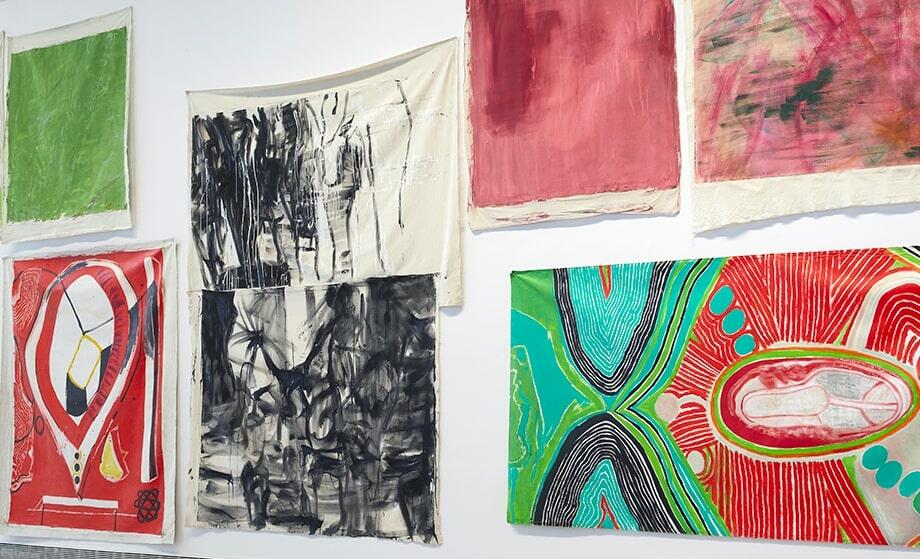
The Swiss-Argentine artist Vivian Suter (Buenos Aires, 1949), decided to leave Basel to live in the Guatemalan jungle after a solo trip through the ruins of Mesoamerica. That was in the early 1980s, and since then her stay has spanned more than thirty years in a studio located in Panajachel, on the grounds of an old coffee plantation by Lake Atitlán. From this personal Eden, surrounded by vegetation and with horizons populated by volcanoes, Suter approaches abstract painting and artistic improvisation from the natural elements that surround her.
There is a link between two cultures in her creations. Born in Argentina to European parents exiled by World War II, her relationship with Latin America is present since childhood. Her canvases are the result of a crossbreeding between the western world and the Guatemalan context: techniques, perspectives and shapes of thought that intermingle on canvas, painting and nature. Beyond the figure of the foreign artist seduced by exoticism, she is an outsider who creates a new link between worldviews.
-
Vivian Suter, sin título, s. f. Cortesía de la artista y Karma International, Zúrich. Fotografía: Flavio Karrer
-
Vivian Suter, sin título, s. f. Cortesía de la artista y Karma International, Zúrich. Fotografía: Flavio Karrer
-
Casa-taller de Vivian Suter, Panajachel, Guatemala, 2019. Fotografía: Teresa Velázquez
-
Casa-taller de Vivian Suter, Panajachel, Guatemala, 2019. Fotografía: Teresa Velázquez
Suter's early works, made in Switzerland in the late 1960s, were more structured. It was not until her arrival in the Guatemalan jungle that the process of work and reflection became more organic and free, especially after the tropical storms Stan, in 2005, and Agatha, in 2010. After the catastrophes, many of her canvases remained partially flooded in the mud, generating pictorial series intervened by the weather’s erratic quality. From that moment on, nature is presented almost as a co-author of the works, which move between the introspection inside her studio and the exterior, where they are impregnated with the wind, rain, mud and even small insects from the environment that map and represent the uniqueness of plant life.
During her childhood in Buenos Aires, Suter used to play hide and seek among the fabrics at her family’s factory, Estampería Belgrano. In the exhibition that the Museo Reina Sofía presents at the Palacio de Velázquez, a similar game takes place that invites the visitor to get lost among the works, colors and textures that hang inside this building with iron and glass vaults.
-
Vista de la exposición Vivian Suter, 2021. Cortesía del Museo Nacional Centro de Arte Reina Sofía.
-
Vista de la exposición Vivian Suter, 2021. Cortesía del Museo Nacional Centro de Arte Reina Sofía.
-
Vista de la exposición Vivian Suter, 2021. Cortesía del Museo Nacional Centro de Arte Reina Sofía.
-
Vista de la exposición Vivian Suter, 2021. Cortesía del Museo Nacional Centro de Arte Reina Sofía.
-
Vista de la exposición Vivian Suter, 2021. Cortesía del Museo Nacional Centro de Arte Reina Sofía.
-
Vista de la exposición Vivian Suter, 2021. Cortesía del Museo Nacional Centro de Arte Reina Sofía.
Related Topics
May interest you
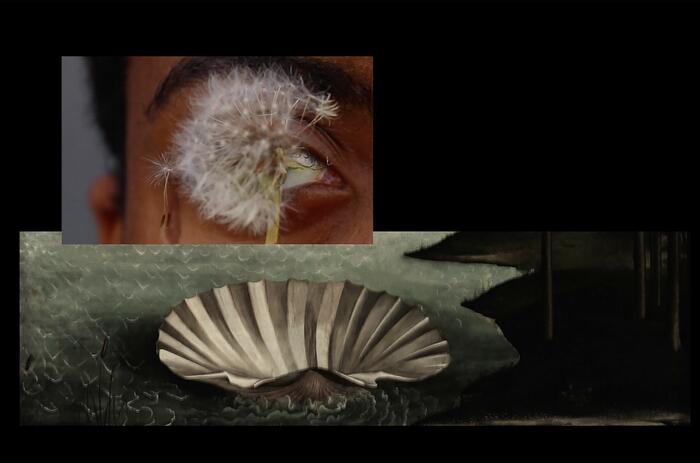
Guest Curator Elvira Dyangani Ose, Director of The Showroom (London), presents the project ‘Contra la raza’ [Against Race] at Matadero Madrid within the framework of PHotoESPAÑA 2021. This multidisciplinary initiative incorporates a video-based installation and live programme focusing on futuristic imaginaries expressed through poetics of the Black experience that generate new forms of global and egalitarian humanism.
MATADERO MADRID PRESENTS “AGAINST RACE” IN COLLABORATION WITH THE SHOWROOM
Guest Curator Elvira Dyangani Ose, Director of The Showroom (London), presents the project ‘Contra la raza’ [Against Race] at Matadero Madrid within the framework of PHotoESPAÑA 2021. This multidisciplinary initiative incorporates a video-based installation and live programme focusing on futuristic imaginaries expressed through poetics of the Black experience that generate new forms of global and egalitarian humanism.

Guest Curator Elvira Dyangani Ose, Director of The Showroom (London), presents the project ‘Contra la raza’ [Against Race] at Matadero Madrid within the framework of PHotoESPAÑA 2021. This multidisciplinary initiative incorporates a video-based installation and live programme focusing on futuristic imaginaries expressed through poetics of the Black experience that generate new forms of global and egalitarian humanism.
MATADERO MADRID PRESENTS “AGAINST RACE” IN COLLABORATION WITH THE SHOWROOM
Guest Curator Elvira Dyangani Ose, Director of The Showroom (London), presents the project ‘Contra la raza’ [Against Race] at Matadero Madrid within the framework of PHotoESPAÑA 2021. This multidisciplinary initiative incorporates a video-based installation and live programme focusing on futuristic imaginaries expressed through poetics of the Black experience that generate new forms of global and egalitarian humanism.
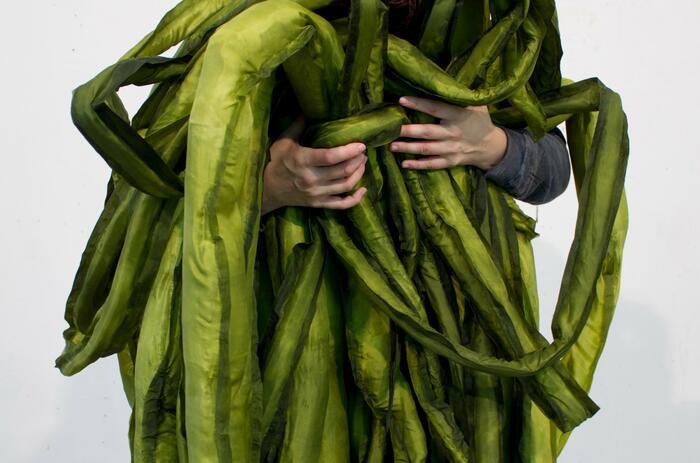
La Casa Encendida (Madrid) and Wellcome Collection (London) present Un Encuentro Vegetal (A Vegetal Encounter), an exhibition that explores our symbiotic relationship with plants as shown through the work of Patricia Domínguez (1984, Santiago de Chile), Ingela Ihrman (1985, Kalmar, Sweden) and Eduardo Navarro (1979, Buenos Aires). Conceived as a dialogue, it shows the Works of these three artists as they deconstruct the omnipresent artificial wall there is between human beings and nature, the wall that is devastating our ecosystems, our life and our health. Curated by Bárbara Rodríguez Muñoz.
LA CASA ENCENDIDA PRESENTS “A VEGETAL ENCOUNTER”, CONTEMPORARY ART AND THOUGHT
La Casa Encendida (Madrid) and Wellcome Collection (London) present Un Encuentro Vegetal (A Vegetal Encounter), an exhibition that explores our symbiotic relationship with plants as shown through the work of Patricia Domínguez (1984, Santiago de Chile), Ingela Ihrman (1985, Kalmar, Sweden) and Eduardo Navarro (1979, Buenos Aires). Conceived as a dialogue, it shows the Works of these three artists as they deconstruct the omnipresent artificial wall there is between human beings and nature, the wall that is devastating our ecosystems, our life and our health. Curated by Bárbara Rodríguez Muñoz.

Commissioned by Liverpool Biennial with support from Amalia Amoedo and Érica Roberts, Bianchi’s works and immersive installation create a locus where the organic is estranged and the industrial is anthromorphic.
INFLATION: DIEGO BIANCHI’S INSTALLATION FOR THE LIVERPOOL BIENNIAL
Commissioned by Liverpool Biennial with support from Amalia Amoedo and Érica Roberts, Bianchi’s works and immersive installation create a locus where the organic is estranged and the industrial is anthromorphic.
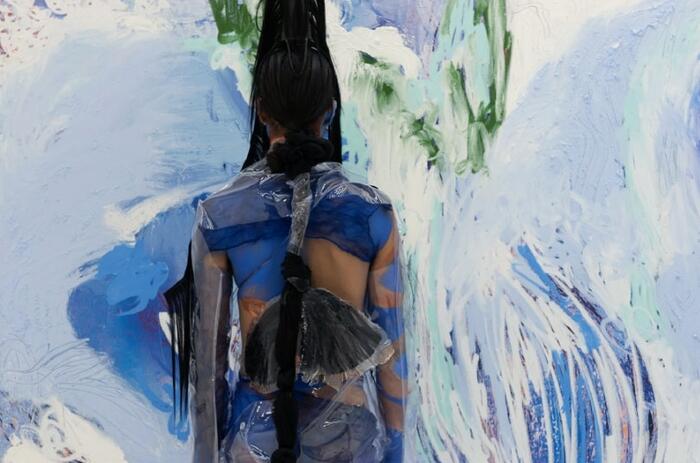
The artworks draw on visual, cultural, and mythological cues informed by feminism, decolonialism and the artist’s personal and familial histories, while simultaneously engaging with the biodiversity, geology, and dark skies of Far West Texas. The sky was particularly striking for Huanca–animated with cosmic and extraterrestrial forces while also revealing the natural rhythms of the sun and moon. ESPEJO QUEMADA is curated by Daisy Nam, Ballroom Marfa curator.
ESPEJO QUEMADA – DONNA HUANCA’S EXPERIMENTAL INSTALLATION AT BALLROOM MARFA
The artworks draw on visual, cultural, and mythological cues informed by feminism, decolonialism and the artist’s personal and familial histories, while simultaneously engaging with the biodiversity, geology, and dark skies of Far West Texas. The sky was particularly striking for Huanca–animated with cosmic and extraterrestrial forces while also revealing the natural rhythms of the sun and moon. ESPEJO QUEMADA is curated by Daisy Nam, Ballroom Marfa curator.
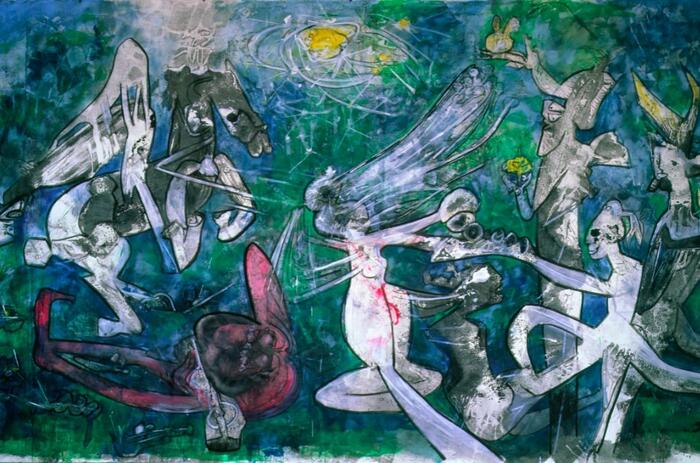
Within the ambitious Collection reorganization that the Reina Sofía Museum is carrying out, the nucleus Los enemigos de la poesía: Resistencias en América Latina (The enemies of poetry: Resistances in Latin America) is presented, focused on Latin art produced between 1964 and 1987 and its relationship with Spain. The political transformations of the time and the appearance of new artistic practices, such as mail art, favored a series of transcendental exchanges for the future of contemporary art.
THE ENEMIES OF POETRY. RESISTANCES IN LATIN AMERICA
Within the ambitious Collection reorganization that the Reina Sofía Museum is carrying out, the nucleus Los enemigos de la poesía: Resistencias en América Latina (The enemies of poetry: Resistances in Latin America) is presented, focused on Latin art produced between 1964 and 1987 and its relationship with Spain. The political transformations of the time and the appearance of new artistic practices, such as mail art, favored a series of transcendental exchanges for the future of contemporary art.
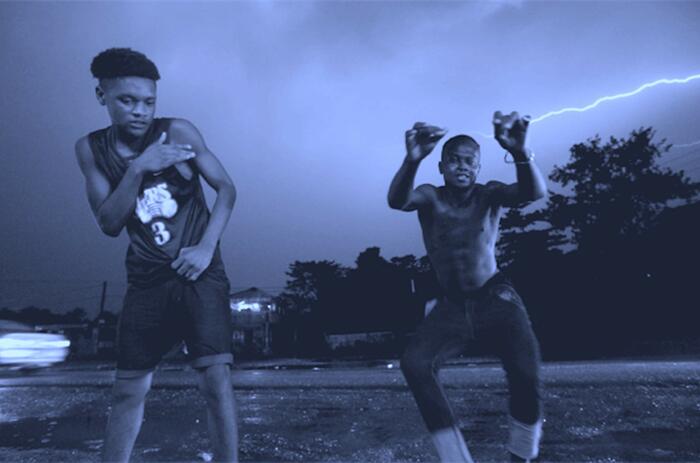
Three recent works by Cecilia Bengolea (b. 1979, Buenos Aires) are featured. She is a multidisciplinary artist whose practice merges video, choreography, and sculpture. Following the thread of water and movement flows, this exhibition presents a selection of works where the artist’s reflection on dance, the sensorial interplay between the body’s interiority and its surroundings, as well as the rhythmical relations of social communities and nature, symptomatically manifest through the choreographic language.
CECILIA BENGOLEA EXHIBITS “ANIMATIONS IN WATER” AT GUGGENHEIM BILBAO
Three recent works by Cecilia Bengolea (b. 1979, Buenos Aires) are featured. She is a multidisciplinary artist whose practice merges video, choreography, and sculpture. Following the thread of water and movement flows, this exhibition presents a selection of works where the artist’s reflection on dance, the sensorial interplay between the body’s interiority and its surroundings, as well as the rhythmical relations of social communities and nature, symptomatically manifest through the choreographic language.
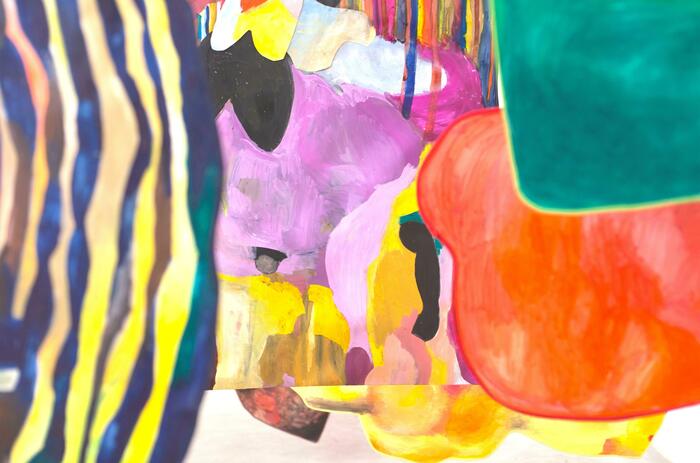
Is a visual manifesto possible? How to show the possible dialogues between art and education? How many images are within each image? How many words are in each word? What's in between? With these questions, the Argentine artist Marina De Caro introduces us to her exhibition Tierra de las emociones perdidas (Land of Lost Emotions), at the Ruth Benzacar gallery in the city of Buenos Aires, which brings together her most recent production.
OTHER POSSIBLE WORLDS
Is a visual manifesto possible? How to show the possible dialogues between art and education? How many images are within each image? How many words are in each word? What's in between? With these questions, the Argentine artist Marina De Caro introduces us to her exhibition Tierra de las emociones perdidas (Land of Lost Emotions), at the Ruth Benzacar gallery in the city of Buenos Aires, which brings together her most recent production.

Guest Curator Elvira Dyangani Ose, Director of The Showroom (London), presents the project ‘Contra la raza’ [Against Race] at Matadero Madrid within the framework of PHotoESPAÑA 2021. This multidisciplinary initiative incorporates a video-based installation and live programme focusing on futuristic imaginaries expressed through poetics of the Black experience that generate new forms of global and egalitarian humanism.
MATADERO MADRID PRESENTS “AGAINST RACE” IN COLLABORATION WITH THE SHOWROOM
Guest Curator Elvira Dyangani Ose, Director of The Showroom (London), presents the project ‘Contra la raza’ [Against Race] at Matadero Madrid within the framework of PHotoESPAÑA 2021. This multidisciplinary initiative incorporates a video-based installation and live programme focusing on futuristic imaginaries expressed through poetics of the Black experience that generate new forms of global and egalitarian humanism.

La Casa Encendida (Madrid) and Wellcome Collection (London) present Un Encuentro Vegetal (A Vegetal Encounter), an exhibition that explores our symbiotic relationship with plants as shown through the work of Patricia Domínguez (1984, Santiago de Chile), Ingela Ihrman (1985, Kalmar, Sweden) and Eduardo Navarro (1979, Buenos Aires). Conceived as a dialogue, it shows the Works of these three artists as they deconstruct the omnipresent artificial wall there is between human beings and nature, the wall that is devastating our ecosystems, our life and our health. Curated by Bárbara Rodríguez Muñoz.
LA CASA ENCENDIDA PRESENTS “A VEGETAL ENCOUNTER”, CONTEMPORARY ART AND THOUGHT
La Casa Encendida (Madrid) and Wellcome Collection (London) present Un Encuentro Vegetal (A Vegetal Encounter), an exhibition that explores our symbiotic relationship with plants as shown through the work of Patricia Domínguez (1984, Santiago de Chile), Ingela Ihrman (1985, Kalmar, Sweden) and Eduardo Navarro (1979, Buenos Aires). Conceived as a dialogue, it shows the Works of these three artists as they deconstruct the omnipresent artificial wall there is between human beings and nature, the wall that is devastating our ecosystems, our life and our health. Curated by Bárbara Rodríguez Muñoz.

Commissioned by Liverpool Biennial with support from Amalia Amoedo and Érica Roberts, Bianchi’s works and immersive installation create a locus where the organic is estranged and the industrial is anthromorphic.
INFLATION: DIEGO BIANCHI’S INSTALLATION FOR THE LIVERPOOL BIENNIAL
Commissioned by Liverpool Biennial with support from Amalia Amoedo and Érica Roberts, Bianchi’s works and immersive installation create a locus where the organic is estranged and the industrial is anthromorphic.

The artworks draw on visual, cultural, and mythological cues informed by feminism, decolonialism and the artist’s personal and familial histories, while simultaneously engaging with the biodiversity, geology, and dark skies of Far West Texas. The sky was particularly striking for Huanca–animated with cosmic and extraterrestrial forces while also revealing the natural rhythms of the sun and moon. ESPEJO QUEMADA is curated by Daisy Nam, Ballroom Marfa curator.
ESPEJO QUEMADA – DONNA HUANCA’S EXPERIMENTAL INSTALLATION AT BALLROOM MARFA
The artworks draw on visual, cultural, and mythological cues informed by feminism, decolonialism and the artist’s personal and familial histories, while simultaneously engaging with the biodiversity, geology, and dark skies of Far West Texas. The sky was particularly striking for Huanca–animated with cosmic and extraterrestrial forces while also revealing the natural rhythms of the sun and moon. ESPEJO QUEMADA is curated by Daisy Nam, Ballroom Marfa curator.

Within the ambitious Collection reorganization that the Reina Sofía Museum is carrying out, the nucleus Los enemigos de la poesía: Resistencias en América Latina (The enemies of poetry: Resistances in Latin America) is presented, focused on Latin art produced between 1964 and 1987 and its relationship with Spain. The political transformations of the time and the appearance of new artistic practices, such as mail art, favored a series of transcendental exchanges for the future of contemporary art.
THE ENEMIES OF POETRY. RESISTANCES IN LATIN AMERICA
Within the ambitious Collection reorganization that the Reina Sofía Museum is carrying out, the nucleus Los enemigos de la poesía: Resistencias en América Latina (The enemies of poetry: Resistances in Latin America) is presented, focused on Latin art produced between 1964 and 1987 and its relationship with Spain. The political transformations of the time and the appearance of new artistic practices, such as mail art, favored a series of transcendental exchanges for the future of contemporary art.

Three recent works by Cecilia Bengolea (b. 1979, Buenos Aires) are featured. She is a multidisciplinary artist whose practice merges video, choreography, and sculpture. Following the thread of water and movement flows, this exhibition presents a selection of works where the artist’s reflection on dance, the sensorial interplay between the body’s interiority and its surroundings, as well as the rhythmical relations of social communities and nature, symptomatically manifest through the choreographic language.
CECILIA BENGOLEA EXHIBITS “ANIMATIONS IN WATER” AT GUGGENHEIM BILBAO
Three recent works by Cecilia Bengolea (b. 1979, Buenos Aires) are featured. She is a multidisciplinary artist whose practice merges video, choreography, and sculpture. Following the thread of water and movement flows, this exhibition presents a selection of works where the artist’s reflection on dance, the sensorial interplay between the body’s interiority and its surroundings, as well as the rhythmical relations of social communities and nature, symptomatically manifest through the choreographic language.

Is a visual manifesto possible? How to show the possible dialogues between art and education? How many images are within each image? How many words are in each word? What's in between? With these questions, the Argentine artist Marina De Caro introduces us to her exhibition Tierra de las emociones perdidas (Land of Lost Emotions), at the Ruth Benzacar gallery in the city of Buenos Aires, which brings together her most recent production.
OTHER POSSIBLE WORLDS
Is a visual manifesto possible? How to show the possible dialogues between art and education? How many images are within each image? How many words are in each word? What's in between? With these questions, the Argentine artist Marina De Caro introduces us to her exhibition Tierra de las emociones perdidas (Land of Lost Emotions), at the Ruth Benzacar gallery in the city of Buenos Aires, which brings together her most recent production.

Guest Curator Elvira Dyangani Ose, Director of The Showroom (London), presents the project ‘Contra la raza’ [Against Race] at Matadero Madrid within the framework of PHotoESPAÑA 2021. This multidisciplinary initiative incorporates a video-based installation and live programme focusing on futuristic imaginaries expressed through poetics of the Black experience that generate new forms of global and egalitarian humanism.
MATADERO MADRID PRESENTS “AGAINST RACE” IN COLLABORATION WITH THE SHOWROOM
Guest Curator Elvira Dyangani Ose, Director of The Showroom (London), presents the project ‘Contra la raza’ [Against Race] at Matadero Madrid within the framework of PHotoESPAÑA 2021. This multidisciplinary initiative incorporates a video-based installation and live programme focusing on futuristic imaginaries expressed through poetics of the Black experience that generate new forms of global and egalitarian humanism.

La Casa Encendida (Madrid) and Wellcome Collection (London) present Un Encuentro Vegetal (A Vegetal Encounter), an exhibition that explores our symbiotic relationship with plants as shown through the work of Patricia Domínguez (1984, Santiago de Chile), Ingela Ihrman (1985, Kalmar, Sweden) and Eduardo Navarro (1979, Buenos Aires). Conceived as a dialogue, it shows the Works of these three artists as they deconstruct the omnipresent artificial wall there is between human beings and nature, the wall that is devastating our ecosystems, our life and our health. Curated by Bárbara Rodríguez Muñoz.
LA CASA ENCENDIDA PRESENTS “A VEGETAL ENCOUNTER”, CONTEMPORARY ART AND THOUGHT
La Casa Encendida (Madrid) and Wellcome Collection (London) present Un Encuentro Vegetal (A Vegetal Encounter), an exhibition that explores our symbiotic relationship with plants as shown through the work of Patricia Domínguez (1984, Santiago de Chile), Ingela Ihrman (1985, Kalmar, Sweden) and Eduardo Navarro (1979, Buenos Aires). Conceived as a dialogue, it shows the Works of these three artists as they deconstruct the omnipresent artificial wall there is between human beings and nature, the wall that is devastating our ecosystems, our life and our health. Curated by Bárbara Rodríguez Muñoz.

Commissioned by Liverpool Biennial with support from Amalia Amoedo and Érica Roberts, Bianchi’s works and immersive installation create a locus where the organic is estranged and the industrial is anthromorphic.
INFLATION: DIEGO BIANCHI’S INSTALLATION FOR THE LIVERPOOL BIENNIAL
Commissioned by Liverpool Biennial with support from Amalia Amoedo and Érica Roberts, Bianchi’s works and immersive installation create a locus where the organic is estranged and the industrial is anthromorphic.

The artworks draw on visual, cultural, and mythological cues informed by feminism, decolonialism and the artist’s personal and familial histories, while simultaneously engaging with the biodiversity, geology, and dark skies of Far West Texas. The sky was particularly striking for Huanca–animated with cosmic and extraterrestrial forces while also revealing the natural rhythms of the sun and moon. ESPEJO QUEMADA is curated by Daisy Nam, Ballroom Marfa curator.
ESPEJO QUEMADA – DONNA HUANCA’S EXPERIMENTAL INSTALLATION AT BALLROOM MARFA
The artworks draw on visual, cultural, and mythological cues informed by feminism, decolonialism and the artist’s personal and familial histories, while simultaneously engaging with the biodiversity, geology, and dark skies of Far West Texas. The sky was particularly striking for Huanca–animated with cosmic and extraterrestrial forces while also revealing the natural rhythms of the sun and moon. ESPEJO QUEMADA is curated by Daisy Nam, Ballroom Marfa curator.

Within the ambitious Collection reorganization that the Reina Sofía Museum is carrying out, the nucleus Los enemigos de la poesía: Resistencias en América Latina (The enemies of poetry: Resistances in Latin America) is presented, focused on Latin art produced between 1964 and 1987 and its relationship with Spain. The political transformations of the time and the appearance of new artistic practices, such as mail art, favored a series of transcendental exchanges for the future of contemporary art.
THE ENEMIES OF POETRY. RESISTANCES IN LATIN AMERICA
Within the ambitious Collection reorganization that the Reina Sofía Museum is carrying out, the nucleus Los enemigos de la poesía: Resistencias en América Latina (The enemies of poetry: Resistances in Latin America) is presented, focused on Latin art produced between 1964 and 1987 and its relationship with Spain. The political transformations of the time and the appearance of new artistic practices, such as mail art, favored a series of transcendental exchanges for the future of contemporary art.

Three recent works by Cecilia Bengolea (b. 1979, Buenos Aires) are featured. She is a multidisciplinary artist whose practice merges video, choreography, and sculpture. Following the thread of water and movement flows, this exhibition presents a selection of works where the artist’s reflection on dance, the sensorial interplay between the body’s interiority and its surroundings, as well as the rhythmical relations of social communities and nature, symptomatically manifest through the choreographic language.
CECILIA BENGOLEA EXHIBITS “ANIMATIONS IN WATER” AT GUGGENHEIM BILBAO
Three recent works by Cecilia Bengolea (b. 1979, Buenos Aires) are featured. She is a multidisciplinary artist whose practice merges video, choreography, and sculpture. Following the thread of water and movement flows, this exhibition presents a selection of works where the artist’s reflection on dance, the sensorial interplay between the body’s interiority and its surroundings, as well as the rhythmical relations of social communities and nature, symptomatically manifest through the choreographic language.

Is a visual manifesto possible? How to show the possible dialogues between art and education? How many images are within each image? How many words are in each word? What's in between? With these questions, the Argentine artist Marina De Caro introduces us to her exhibition Tierra de las emociones perdidas (Land of Lost Emotions), at the Ruth Benzacar gallery in the city of Buenos Aires, which brings together her most recent production.
OTHER POSSIBLE WORLDS
Is a visual manifesto possible? How to show the possible dialogues between art and education? How many images are within each image? How many words are in each word? What's in between? With these questions, the Argentine artist Marina De Caro introduces us to her exhibition Tierra de las emociones perdidas (Land of Lost Emotions), at the Ruth Benzacar gallery in the city of Buenos Aires, which brings together her most recent production.

Guest Curator Elvira Dyangani Ose, Director of The Showroom (London), presents the project ‘Contra la raza’ [Against Race] at Matadero Madrid within the framework of PHotoESPAÑA 2021. This multidisciplinary initiative incorporates a video-based installation and live programme focusing on futuristic imaginaries expressed through poetics of the Black experience that generate new forms of global and egalitarian humanism.
MATADERO MADRID PRESENTS “AGAINST RACE” IN COLLABORATION WITH THE SHOWROOM
Guest Curator Elvira Dyangani Ose, Director of The Showroom (London), presents the project ‘Contra la raza’ [Against Race] at Matadero Madrid within the framework of PHotoESPAÑA 2021. This multidisciplinary initiative incorporates a video-based installation and live programme focusing on futuristic imaginaries expressed through poetics of the Black experience that generate new forms of global and egalitarian humanism.

La Casa Encendida (Madrid) and Wellcome Collection (London) present Un Encuentro Vegetal (A Vegetal Encounter), an exhibition that explores our symbiotic relationship with plants as shown through the work of Patricia Domínguez (1984, Santiago de Chile), Ingela Ihrman (1985, Kalmar, Sweden) and Eduardo Navarro (1979, Buenos Aires). Conceived as a dialogue, it shows the Works of these three artists as they deconstruct the omnipresent artificial wall there is between human beings and nature, the wall that is devastating our ecosystems, our life and our health. Curated by Bárbara Rodríguez Muñoz.
LA CASA ENCENDIDA PRESENTS “A VEGETAL ENCOUNTER”, CONTEMPORARY ART AND THOUGHT
La Casa Encendida (Madrid) and Wellcome Collection (London) present Un Encuentro Vegetal (A Vegetal Encounter), an exhibition that explores our symbiotic relationship with plants as shown through the work of Patricia Domínguez (1984, Santiago de Chile), Ingela Ihrman (1985, Kalmar, Sweden) and Eduardo Navarro (1979, Buenos Aires). Conceived as a dialogue, it shows the Works of these three artists as they deconstruct the omnipresent artificial wall there is between human beings and nature, the wall that is devastating our ecosystems, our life and our health. Curated by Bárbara Rodríguez Muñoz.

Commissioned by Liverpool Biennial with support from Amalia Amoedo and Érica Roberts, Bianchi’s works and immersive installation create a locus where the organic is estranged and the industrial is anthromorphic.
INFLATION: DIEGO BIANCHI’S INSTALLATION FOR THE LIVERPOOL BIENNIAL
Commissioned by Liverpool Biennial with support from Amalia Amoedo and Érica Roberts, Bianchi’s works and immersive installation create a locus where the organic is estranged and the industrial is anthromorphic.

The artworks draw on visual, cultural, and mythological cues informed by feminism, decolonialism and the artist’s personal and familial histories, while simultaneously engaging with the biodiversity, geology, and dark skies of Far West Texas. The sky was particularly striking for Huanca–animated with cosmic and extraterrestrial forces while also revealing the natural rhythms of the sun and moon. ESPEJO QUEMADA is curated by Daisy Nam, Ballroom Marfa curator.
ESPEJO QUEMADA – DONNA HUANCA’S EXPERIMENTAL INSTALLATION AT BALLROOM MARFA
The artworks draw on visual, cultural, and mythological cues informed by feminism, decolonialism and the artist’s personal and familial histories, while simultaneously engaging with the biodiversity, geology, and dark skies of Far West Texas. The sky was particularly striking for Huanca–animated with cosmic and extraterrestrial forces while also revealing the natural rhythms of the sun and moon. ESPEJO QUEMADA is curated by Daisy Nam, Ballroom Marfa curator.

Within the ambitious Collection reorganization that the Reina Sofía Museum is carrying out, the nucleus Los enemigos de la poesía: Resistencias en América Latina (The enemies of poetry: Resistances in Latin America) is presented, focused on Latin art produced between 1964 and 1987 and its relationship with Spain. The political transformations of the time and the appearance of new artistic practices, such as mail art, favored a series of transcendental exchanges for the future of contemporary art.
THE ENEMIES OF POETRY. RESISTANCES IN LATIN AMERICA
Within the ambitious Collection reorganization that the Reina Sofía Museum is carrying out, the nucleus Los enemigos de la poesía: Resistencias en América Latina (The enemies of poetry: Resistances in Latin America) is presented, focused on Latin art produced between 1964 and 1987 and its relationship with Spain. The political transformations of the time and the appearance of new artistic practices, such as mail art, favored a series of transcendental exchanges for the future of contemporary art.

Three recent works by Cecilia Bengolea (b. 1979, Buenos Aires) are featured. She is a multidisciplinary artist whose practice merges video, choreography, and sculpture. Following the thread of water and movement flows, this exhibition presents a selection of works where the artist’s reflection on dance, the sensorial interplay between the body’s interiority and its surroundings, as well as the rhythmical relations of social communities and nature, symptomatically manifest through the choreographic language.
CECILIA BENGOLEA EXHIBITS “ANIMATIONS IN WATER” AT GUGGENHEIM BILBAO
Three recent works by Cecilia Bengolea (b. 1979, Buenos Aires) are featured. She is a multidisciplinary artist whose practice merges video, choreography, and sculpture. Following the thread of water and movement flows, this exhibition presents a selection of works where the artist’s reflection on dance, the sensorial interplay between the body’s interiority and its surroundings, as well as the rhythmical relations of social communities and nature, symptomatically manifest through the choreographic language.

Is a visual manifesto possible? How to show the possible dialogues between art and education? How many images are within each image? How many words are in each word? What's in between? With these questions, the Argentine artist Marina De Caro introduces us to her exhibition Tierra de las emociones perdidas (Land of Lost Emotions), at the Ruth Benzacar gallery in the city of Buenos Aires, which brings together her most recent production.
OTHER POSSIBLE WORLDS
Is a visual manifesto possible? How to show the possible dialogues between art and education? How many images are within each image? How many words are in each word? What's in between? With these questions, the Argentine artist Marina De Caro introduces us to her exhibition Tierra de las emociones perdidas (Land of Lost Emotions), at the Ruth Benzacar gallery in the city of Buenos Aires, which brings together her most recent production.

Guest Curator Elvira Dyangani Ose, Director of The Showroom (London), presents the project ‘Contra la raza’ [Against Race] at Matadero Madrid within the framework of PHotoESPAÑA 2021. This multidisciplinary initiative incorporates a video-based installation and live programme focusing on futuristic imaginaries expressed through poetics of the Black experience that generate new forms of global and egalitarian humanism.
MATADERO MADRID PRESENTS “AGAINST RACE” IN COLLABORATION WITH THE SHOWROOM
Guest Curator Elvira Dyangani Ose, Director of The Showroom (London), presents the project ‘Contra la raza’ [Against Race] at Matadero Madrid within the framework of PHotoESPAÑA 2021. This multidisciplinary initiative incorporates a video-based installation and live programme focusing on futuristic imaginaries expressed through poetics of the Black experience that generate new forms of global and egalitarian humanism.

La Casa Encendida (Madrid) and Wellcome Collection (London) present Un Encuentro Vegetal (A Vegetal Encounter), an exhibition that explores our symbiotic relationship with plants as shown through the work of Patricia Domínguez (1984, Santiago de Chile), Ingela Ihrman (1985, Kalmar, Sweden) and Eduardo Navarro (1979, Buenos Aires). Conceived as a dialogue, it shows the Works of these three artists as they deconstruct the omnipresent artificial wall there is between human beings and nature, the wall that is devastating our ecosystems, our life and our health. Curated by Bárbara Rodríguez Muñoz.
LA CASA ENCENDIDA PRESENTS “A VEGETAL ENCOUNTER”, CONTEMPORARY ART AND THOUGHT
La Casa Encendida (Madrid) and Wellcome Collection (London) present Un Encuentro Vegetal (A Vegetal Encounter), an exhibition that explores our symbiotic relationship with plants as shown through the work of Patricia Domínguez (1984, Santiago de Chile), Ingela Ihrman (1985, Kalmar, Sweden) and Eduardo Navarro (1979, Buenos Aires). Conceived as a dialogue, it shows the Works of these three artists as they deconstruct the omnipresent artificial wall there is between human beings and nature, the wall that is devastating our ecosystems, our life and our health. Curated by Bárbara Rodríguez Muñoz.

Commissioned by Liverpool Biennial with support from Amalia Amoedo and Érica Roberts, Bianchi’s works and immersive installation create a locus where the organic is estranged and the industrial is anthromorphic.
INFLATION: DIEGO BIANCHI’S INSTALLATION FOR THE LIVERPOOL BIENNIAL
Commissioned by Liverpool Biennial with support from Amalia Amoedo and Érica Roberts, Bianchi’s works and immersive installation create a locus where the organic is estranged and the industrial is anthromorphic.

The artworks draw on visual, cultural, and mythological cues informed by feminism, decolonialism and the artist’s personal and familial histories, while simultaneously engaging with the biodiversity, geology, and dark skies of Far West Texas. The sky was particularly striking for Huanca–animated with cosmic and extraterrestrial forces while also revealing the natural rhythms of the sun and moon. ESPEJO QUEMADA is curated by Daisy Nam, Ballroom Marfa curator.
ESPEJO QUEMADA – DONNA HUANCA’S EXPERIMENTAL INSTALLATION AT BALLROOM MARFA
The artworks draw on visual, cultural, and mythological cues informed by feminism, decolonialism and the artist’s personal and familial histories, while simultaneously engaging with the biodiversity, geology, and dark skies of Far West Texas. The sky was particularly striking for Huanca–animated with cosmic and extraterrestrial forces while also revealing the natural rhythms of the sun and moon. ESPEJO QUEMADA is curated by Daisy Nam, Ballroom Marfa curator.

Within the ambitious Collection reorganization that the Reina Sofía Museum is carrying out, the nucleus Los enemigos de la poesía: Resistencias en América Latina (The enemies of poetry: Resistances in Latin America) is presented, focused on Latin art produced between 1964 and 1987 and its relationship with Spain. The political transformations of the time and the appearance of new artistic practices, such as mail art, favored a series of transcendental exchanges for the future of contemporary art.
THE ENEMIES OF POETRY. RESISTANCES IN LATIN AMERICA
Within the ambitious Collection reorganization that the Reina Sofía Museum is carrying out, the nucleus Los enemigos de la poesía: Resistencias en América Latina (The enemies of poetry: Resistances in Latin America) is presented, focused on Latin art produced between 1964 and 1987 and its relationship with Spain. The political transformations of the time and the appearance of new artistic practices, such as mail art, favored a series of transcendental exchanges for the future of contemporary art.

Three recent works by Cecilia Bengolea (b. 1979, Buenos Aires) are featured. She is a multidisciplinary artist whose practice merges video, choreography, and sculpture. Following the thread of water and movement flows, this exhibition presents a selection of works where the artist’s reflection on dance, the sensorial interplay between the body’s interiority and its surroundings, as well as the rhythmical relations of social communities and nature, symptomatically manifest through the choreographic language.
CECILIA BENGOLEA EXHIBITS “ANIMATIONS IN WATER” AT GUGGENHEIM BILBAO
Three recent works by Cecilia Bengolea (b. 1979, Buenos Aires) are featured. She is a multidisciplinary artist whose practice merges video, choreography, and sculpture. Following the thread of water and movement flows, this exhibition presents a selection of works where the artist’s reflection on dance, the sensorial interplay between the body’s interiority and its surroundings, as well as the rhythmical relations of social communities and nature, symptomatically manifest through the choreographic language.

Is a visual manifesto possible? How to show the possible dialogues between art and education? How many images are within each image? How many words are in each word? What's in between? With these questions, the Argentine artist Marina De Caro introduces us to her exhibition Tierra de las emociones perdidas (Land of Lost Emotions), at the Ruth Benzacar gallery in the city of Buenos Aires, which brings together her most recent production.
OTHER POSSIBLE WORLDS
Is a visual manifesto possible? How to show the possible dialogues between art and education? How many images are within each image? How many words are in each word? What's in between? With these questions, the Argentine artist Marina De Caro introduces us to her exhibition Tierra de las emociones perdidas (Land of Lost Emotions), at the Ruth Benzacar gallery in the city of Buenos Aires, which brings together her most recent production.




